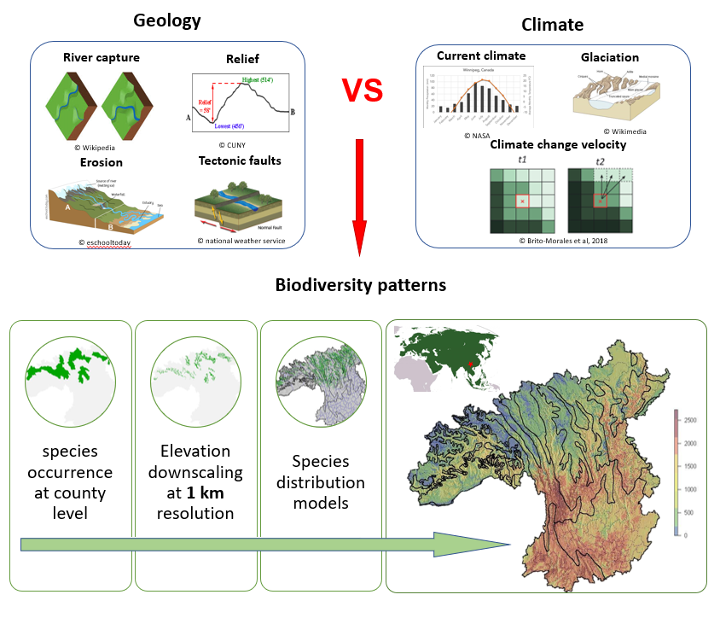BECCY
Mountains are biodiversity hotspots, known for harboring hyper diverse communities in relation to the area. Macroecological biodiversity studies show that this richness can not be explained by contemporary climate alone. The complex interactions between geological history and climate provide unique ecological opportunities for species to diversify, leading to high species diversity as well as increased rates of endemism in mountains. The Hengduan Mountains region (hereafter as HDM), as one of the largest global biodiversity hotspot outside of the tropics, has fascinating geological and climate histories due to the high uplift rate caused by Indian-Eurasia plate collision and monsoon intensification. These unique and complex histories have shaped landscapes of HDM across millionaire scale, driving a range of different biological and evolutionary processes to shape this unique biodiversity hotspot. However, little is known about the relative influence of geological and climate processes in the HDM region and how these processes in concert with biological adaptation and dispersal (limitations) have shaped plant and fish biodiversity patterns at finer scales. The Biodiversity, Earth, Climate Coupling in Yunnan (BECCY) project will investigate these knowledge gaps, bridging geology, climatology and ecology. BECCY is a trans-disciplinary, international collaboration, bringing together seven professorships from three departments in the ETH Domain (incl. ETH Zürich, WSL, and Eawag) as well as seven professors from four institutes across China. In this project, the ELE lab is focusing on the biosphere in the HDM, mapping high resolution biodiversity patterns of plant and fishes with statistical modeling and eDNA techniques.
Yaquan’s project is to understand the impact of geological and climate processes on plant biodiversity patterns in the Hengduan Mts region. She uses species distribution models based on compiled occurrence data, to develop high resolution (i.e. 1 km) biodiversity maps. Taking advantage of this technique, she will be able to capture the variation of geological and climate processes within the HDM to better understand biodiversity maintenance mechanisms. On the second face of her PhD, she will conduct a fieldwork to test the efficiency of geological features acting as dispersal barriers for genetic diversity of plant at local scale. Her doctoral thesis will provide a novel insight how geological and climate processes have shaped multi-dimensional biodiversity patterns of plants in the HDM biodiversity hotspot.
Zili’s project is to explore the impact of the geological and climatic history of the HDM on plant endemism. He will explore patterns and hotpsots of plant endemism to understand the potential process shaping the high degree of endemism in the HDM biodiversity hotspot. In the second part, Zillis aim is to understand the exact mechanisms of speciation which formed the local plant endemism. He will reconst the phylogenies of representative local clades, and analyse the phylogenies according to its sister species’ occurences across the HDM. In the end, Zili’s thesis will provide a comprehensive summary of the interplays between the geological and climatic processes and their effects on the speciation of plant endemism.
Dominik is focusing on biodiversity patterns within the river networks flowing through the Hengduan mountains. The geological history , like quick uplift and subsequent erosion processes, probably lead to rerouting of channels (river capture) within and between river basins leaving imprints in riverine communities. In his thesis, Dominik uses state of the art environmental DNA (eDNA) based metabarcoding in different river systems to uncover fish diversity, linking it to geological and contemporary history and identifies characteristics of river captures. In the HDM he will collect samples from the Yangtze, the Salween, and the upper Mekong, which will enable to get high resolution community data of this rivers. This information will then be used to identify possible biotic fingerprints of river capture, and thus supporting the overall goal of the BECCY project.
Collaborator: https://earthsurfacedynamics.ethz.ch/research/tectonics-landscape-evolution.html
Contact
Yaquan Chang:
Zili Yuan:
Dominik Kirschner:

